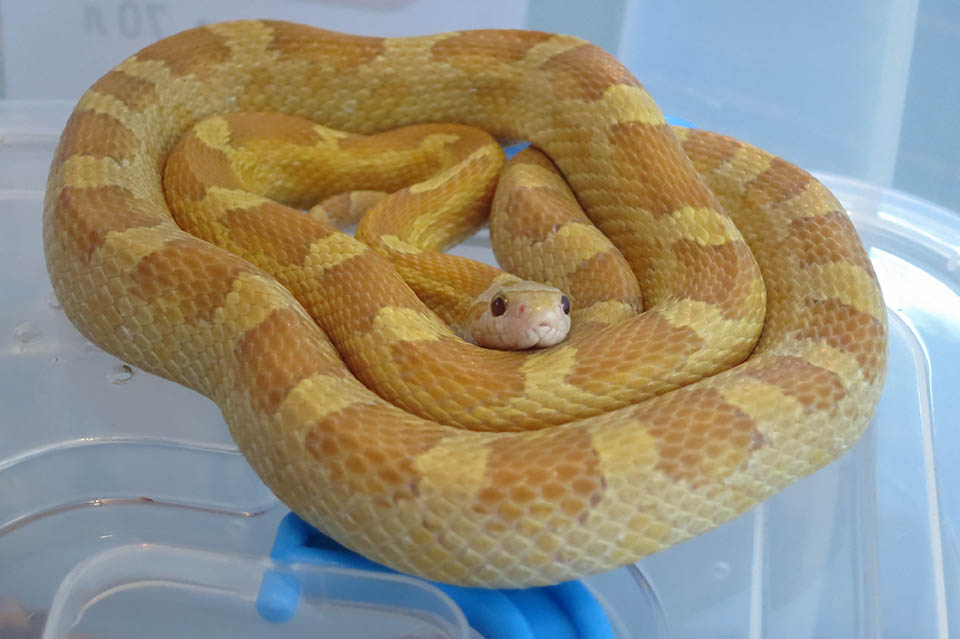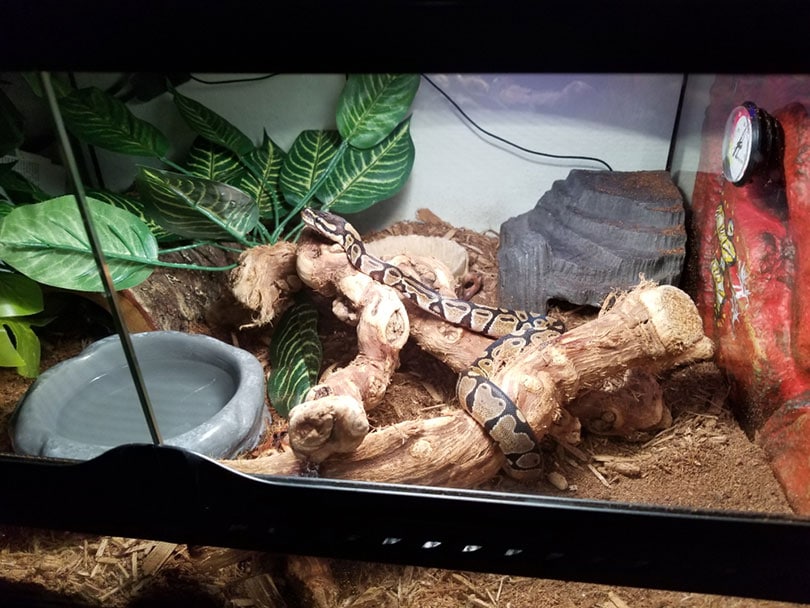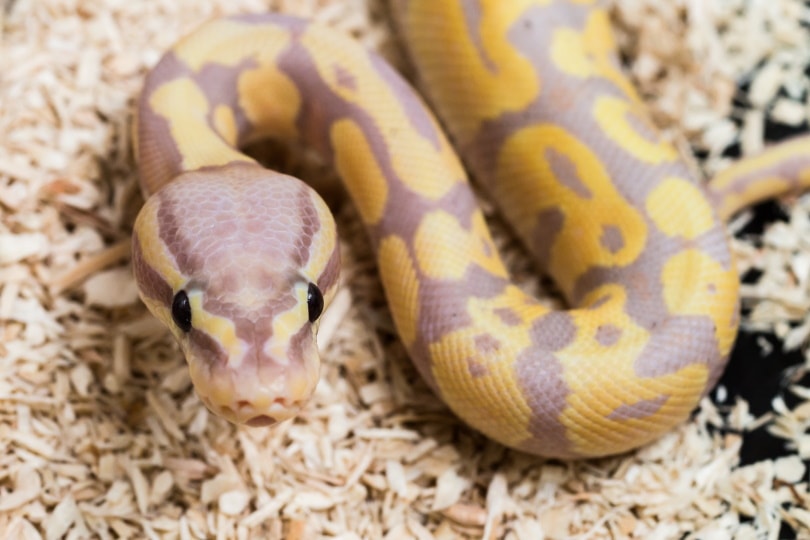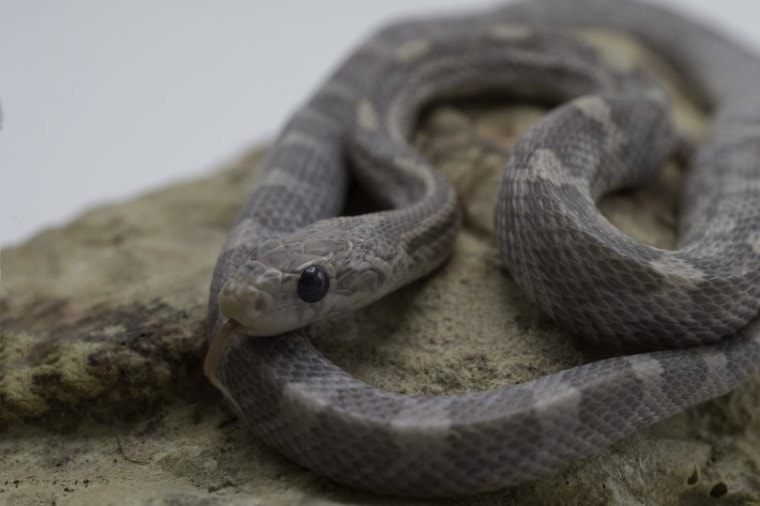
The Lavender Corn snake is an increasingly popular snake due to its striking color. It’s non-venomous and native to the United States, so it’s not hard to find a breeder, especially with their popularity on the rise. If you are thinking about purchasing one of these snakes but would like to learn more about it, keep reading while we discuss habitat, lifespan, cost, and more to help you determine if it’s right for you.
Quick Facts about Lavender Corn Snake

| Species Name: | Elaphe guttata |
| Common Name: | Corn Snake |
| Care Level: | Beginner |
| Lifespan: | 15 – 20 years |
| Adult Size: | 4 – 5 feet |
| Diet: | Mice |
| Minimum Tank Size: | 20 gallons |
| Temperature & Humidity | 75 – 85 degrees 65% – 75% humidity |
Do Lavender Corn Snakes Make Good Pets?
Yes. The Lavender Corn Snaked makes a fantastic first pet for children and adults. Its brilliant purple color is captivating, and its docile temperament makes it easy to handle. It’s more active than a Ball Python, so it’s fun to watch, and it’s not hard to raise.

Appearance
As the name implies, the lavender corn snake has a purple tint to its skin but is otherwise the same as other corn snakes. It usually grows more than four feet long, and it usually has a darker pattern on its back. These patterns can change through selective breeding, like the colors, so there is a wide range of possibilities for the appearance of your corn snake. The belly will be plain without a darker pattern.
How to Take Care of Lavender Corn Snakes
Habitat, Tank Conditions & Setup
Tank
Your Lavender Corn Snake will require a 20-gallon tank minimum, but a 40-gallon tank is much more suitable and will allow you to create a better habitat with branches and live plants that your snake will enjoy. You will need a screen top to allow plenty of ventilation. Your snake will also need a few hides large enough to fit its entire body inside when it wants to get out of the heat or feels threatened.
Lighting
Your corn snake will not require any special lighting, and you can use whatever you have available. These snakes are most active at dusk and dawn when there is very little ultraviolet light, so you will not need to add it to the environment. Some owners choose to use fluorescent lighting to help bring out the lavender color, but it is not required.
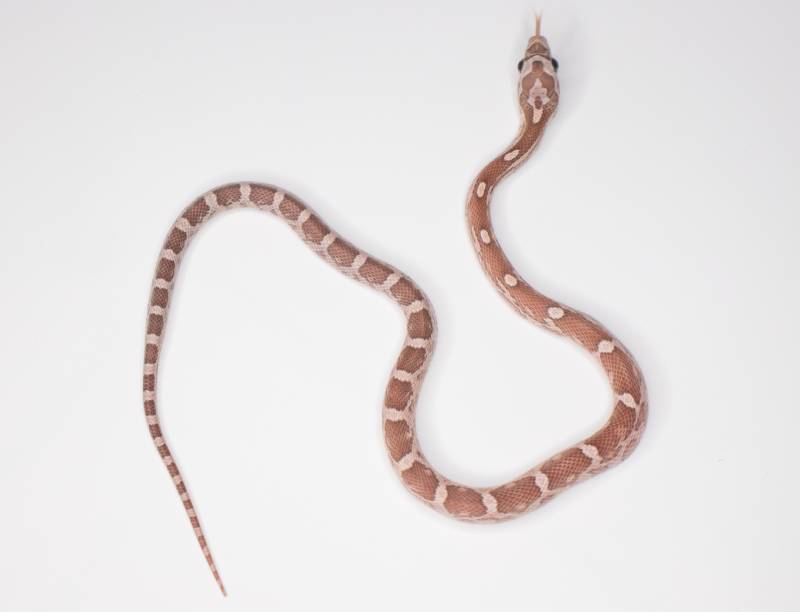
Heating (Temperature & Humidity)
Temperature
You can use heating lamps or ceramic heaters to increase the temperature in your aquarium to between 75 and 85 degrees. The temperature can be as low as 70 degrees as long as there is a hot spot where the snake can warm up.
Humidity
You’ll need to try to keep the humidity between 65% and 75%, especially when your snake is shedding its skin to help make the process easier. A hygrometer can help you keep an eye on your humidity levels and you can use a spray bottle and water bowl to add more moisture to the air.
Substrate
We recommend using aspen as the substrate for your Lavender Corn Snake. This softwood material helps retain humidity, and it allows your snake to burrow and hide. You can also use cypress wood, hemp, and similar materials.
Tank Recommendation
| Tank Type: | 40-gallon glass vivarium |
| Lighting: | Standard |
| Heating: | Heating pad/tape on the bottom of the enclosure, ceramic heater, heat lamp |
| Best Substrate: | Aspen bedding |
Feeding Your Lavender Corn Snake
Your lavender Corn Snake will primarily eat pre-killed frozen mice. This food will provide your pet with everything it needs to live a long and healthy life. Since it eats the mice whole, it gets the calcium it needs from the bones it digests, so there is no need for a powdered supplement that most other captive reptiles require. Since the food is pre-killed and frozen, it’s easy to purchase, and there is less risk your snake will get parasites.

Diet Summary
| Fruits: | 0% of the diet |
| Insects: | 0% of diet |
| Meat: | 100% of diet – small/medium-sized mice |
| Supplements Required: | None |
Keeping Your Lavender Corn Snake Healthy
Keeping your Lavender Corn Snake healthy is not difficult as long as you keep the temperature and humidity within accepted limits, especially when it’s shedding. Pre-killed and frozen mice will not pass on parasites to your snake like wild-caught food might, so there is much less risk of digestive problems and other health risks.
Common Health Issues
The primary health issue associated with Lavender Corn Snakes involves the shedding of their skin. If there is not enough humidity in the air, the skin will break apart in pieces, and bacteria can grow on any pieces stuck to the body. You can assist the snake using tweezers, but it’s much better to increase the humidity level at the first sign of shedding, usually when the eyes change color.

Lifespan
If you keep your snake well-fed and in the proper habitat, you can expect it to live 15 – 20 years, with very few health issues.
Breeding
Most experts recommend allowing the female corn snake to enter brumation in cooler temperatures from December to February before breeding to help prepare. Breeding without brumation may be too difficult on the body. Once the snakes wake up, they will be ready to mate. Increase the humidity by using a spray bottle to moisten the substrate. Add the male to the female’s habitat and wait several minutes. If the snakes intertwine, the mating process has begun.
Are Lavender Corn Snakes Friendly? Our Handling Advice
Yes. The Lavender Corn Snake is a friendly snake that doesn’t mind when you pick it up. Handling it for a few minutes each day will help get the snake used to you, and you will be able to hold it longer. Always wait until the snake is calm to return it to its cage and wait at least 48 hours after feeding to pick it up.

Shedding & Brumation: What to Expect
Your Lavender Corn Snake can stay active year-round as long as the temperature is high. The only reason to lower the temperature to allow brumation to occur is before you start breeding. However, your snake will shed its skin every few weeks, and each time it does, there is a potential danger that it will struggle breaking free of the skin, especially around the eyes. Proper humidity is the best way to make sure the process goes smoothly.
How Much Do Lavender Corn Snakes Cost?
You can expect to pay between $40 and $80 for your Lavender Corn Snake. This color is fairly popular and easy to create, so it shouldn’t be too difficult to find a breeder that can get you one. Most large commercial breeders have them in stock, so there is no waiting period, and many can ship them overnight, especially during the warmer months.
Care Guide Summary
Conclusion
The Lavender Corn Snake is one of the most attractive of all the Corn Snake breeds. Its striking purple color will stand out in any habitat, especially if you are using fluorescent lighting. These snakes are easy to maintain and primarily eat only mice. It also enjoys being handled and is perfect for children. The only challenge is maintaining enough humidity in the aquarium for proper shedding.
We hope you have enjoyed our look into this attractive snake and found the answers you need. If we have helped convince you to purchase one for your home, please share this guide to the Lavender Corn Snake on Facebook and Twitter.
Featured Image Credit: Diane Hawkins, Shutterstock



